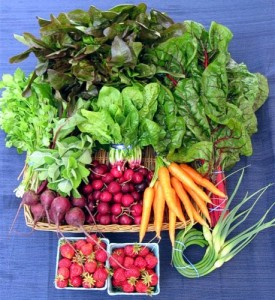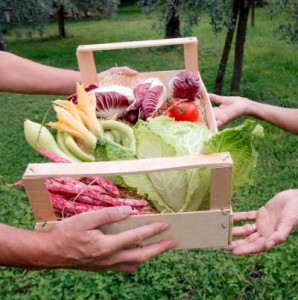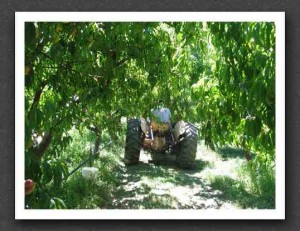 What is a CSA? CSA stands for “Community Supported Agriculture” and is a way for people to directly support local farms while reaping the benefit of fresh, locally grown produce. The community supports the farms by not just being a customer, but a farm ‘”share holder” for the season. Consumers pay in advance for a “share” of the farm’s seasonal harvest. The purchased shares help local farms pay for pre-harvest expenses such as seed, fertilizer and labor. Knowing that the consumers have a vested interest in the harvest gives farmers added incentive to provide high quality produce for them. In a typical CSA agreement customers (a.k.a. share holders) receive a bag or box of locally grown produce every week. This is either delivered to their homes or to a designated local pick up location.
What is a CSA? CSA stands for “Community Supported Agriculture” and is a way for people to directly support local farms while reaping the benefit of fresh, locally grown produce. The community supports the farms by not just being a customer, but a farm ‘”share holder” for the season. Consumers pay in advance for a “share” of the farm’s seasonal harvest. The purchased shares help local farms pay for pre-harvest expenses such as seed, fertilizer and labor. Knowing that the consumers have a vested interest in the harvest gives farmers added incentive to provide high quality produce for them. In a typical CSA agreement customers (a.k.a. share holders) receive a bag or box of locally grown produce every week. This is either delivered to their homes or to a designated local pick up location.
Most CSAs offer various sizes of orders to accommodate the needs of large or small families (or singles). What a CSA box or bag contains may differ between CSAs. The most common is for a CSA bag/box to be sort of a “surprise package” that contains whatever happens to be in season – often a mix of fruits and vegetables. Some agreements allow for customers to choose between a “mixed bag”, “just fruits” or “just vegetables.” Some allow for customers to be informed ahead of time what is going into the CSA box/bag and to “opt out” of receiving certain items if they prefer. Each contract and CSA does things a little differently, but the end result is a supply of fresh, locally grown produce for consumers, and community support for local farmers that helps ensure they stay in business (and able to continue supplying us with that great produce!).
For many people, receiving a weekly CSA box or bag presents both a blessing and a challenge. The positives include a reliable source of fresh produce that they are committed to receiving, and therefore are likely to eat. This is a great way to help increase your daily servings of fruits and veggies! Simply put, we are more likely to eat fruits and veggies if they are already in our homes; and it helps not to have to give much thought about what or when to shop for them. The challenge comes in eating it all before it goes to waste, and in figuring out what to do with some of the more obscure items in the CSA delivery. (What DOES one do with a kohlrabi, for example?)
The solution is two-fold, and really just sort of forces us to establish healthy habits that I encourage most of my clients to form any way. One of the things that most helps anybody be successful at healthy eating is planning ahead. I suggest taking one day a week to plan out your meals for the week (even if it’s a tentative plan). This can mean planning 7 dinners for the week, or it can mean planning 4 meals and 3 nights of leftovers…whatever works best for you and/or your family. In the U.S. meals are generally planned around meat/protein, and vegetables are often more of an after-thought. I often encourage my clients to plan their meals around the veggies and figure out what kind of protein will go with them. It’s generally a much healthier way to plan a meal. When you have CSA produce that needs to be used up…it becomes a catalyst for this type of meal planning. I love it! I also like that being introduced to produce we might not normally purchase helps to stretch our repertoire of fresh, healthy choices. I enjoy figuring out how to prepare new or unusual foods, and am happy to help others to do the same. To me, CSA boxes provide opportunities rather than challenges.
Community Supported Agriculture connects local farmers with local consumers in a unique way. CSA’s allow community members to honor and embrace local growers and producers; and provide a means of improving the health of local consumers. If you haven’t yet tried a CSA, I encourage you to do so. CSAs are a win-win opportunity for local farms and for our health.
Follow this link to find a local CSA near you.

